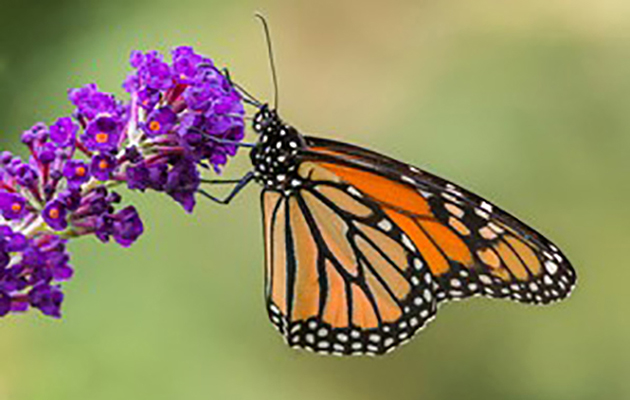
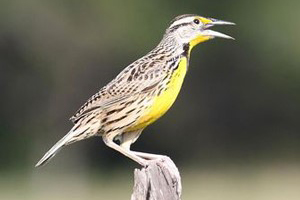
Eastern Meadowlark
(Sturnella Magna)Length: 19 to 26 cm
Wingspan: 35 to 40 cm
The Eastern Meadowlark is a medium-sized songbird and a member of the blackbird family. It has a relatively long, pointed bill and short tail. Adults are patterned with brown on the back, and have a bright-yellow throat and belly with a large black ‘V’ pattern in the middle of the chest. The white outer tail feathers are especially visible in flight. Sixteen subspecies of the Eastern Meadowlark are recognized, but only one occurs in Canada.
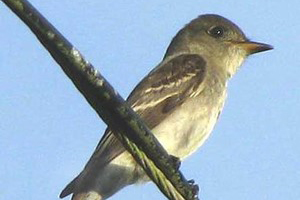
Eastern Wood-Pewee
(Contopus virens)Length: 15 cm
Wingspan: 23 to 26 cm
The Eastern Wood-Pewee is a small forest bird about the same size as a House Sparrow. Both sexes have similar plumage, generally greyish-olive on the upperparts and pale on the underparts. This species is often observed perched in an upright position typical of flycatchers.
During breeding season, you may hear the Eastern Wood-pewee’s distinctive, three-phrased whistled song, “pee-ah-wee.”
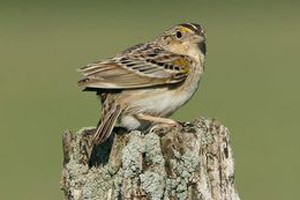
Grasshopper Sparrow
(Ammodramus savannarum pratensis)Length: 10.5 to 13 cm
Wingspan: 17.5 cm
The Grasshopper Sparrow is a small, dull-coloured song bird of grassland habitats. It has a short tail, flat head and conical beige bill. Adults of both sexes have similar plumage – a plain buff-coloured throat and breast, buff, unmarked or faintly marked flanks, whitish below and mottled with rust above. Its summer diet is largely composed of grasshoppers and so the Eastern Grasshopper Sparrow is considered beneficial for agriculture!
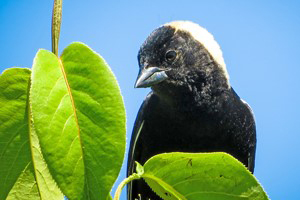
Bobolink
(Dolichonyx oryzivorus)Length: 15 to 21 cm
Wingspan: 27 cm
The Bobolink is a medium-sized passerine. Males are black below and lighter above, while females are light beige streaked with brown and could be mistaken for some species of sparrow. The Bobolink has a conical bill, rigid, sharply pointed tail feathers and long hind toenails. Male plumage outside the breeding season and juvenile plumage are similar to that of the female.
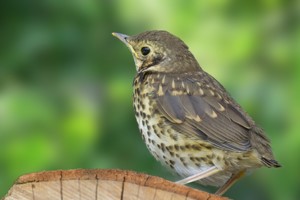
Wood Thrush
(Hylocichla mustelina)Length: 20 cm
Wingspan: 30 to 34 cm
The Wood Thrush is a medium-sized Neotropical migrant, slightly smaller than the American Robin. Sexes are similar; adults are generally rusty-brown on the upperparts with white underparts and large blackish spots on the breast and flanks. Juveniles are similar to adults, but have tawny streaks and spots on the back, neck, and wing coverts.

Monarch Butterfly
(Danaus plexippus)Wingspan: 93 to 105 mm
The adult Monarch is a large, showy butterfly with predominantly orange wings outlined by a broad black border and two rows of circular white spots. The Monarch is used in classrooms all over North America to teach children about biology, metamorphosis, conservation, and an appreciation for nature. The Monarch is one of a few butterflies that migrate. Their migration from southern Canada to Mexico has been described as an endangered biological phenomenon.
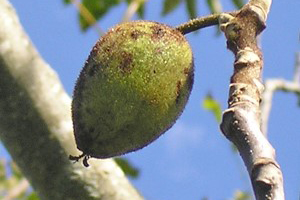
Butternut Tree
(Juglans cinerea)Height: 20-30 m
Diameter: 45-90 cm
Leaflets: 9 to 15 cm long
The Butternut is a medium to large, deciduous tree of the walnut family reaching a height of up to 30 m. Its leaves are densely hairy, alternate, and composed of 11-17 pinnately-arranged, stalk-less leaflets. The Butternut fruit is a sticky-hairy, egg-shaped husk enclosing a single two-chambered nut within a hard, jagged-ridged shell. Butternut is one of only two walnut species native to Canada. The species is prized for its wood and edible nuts and was an important source of food and medicine for First Nations people.
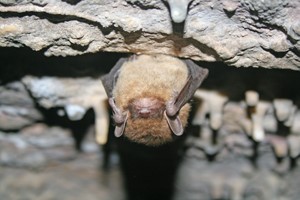
Little Brown Bat
(Myotis lucifugus)Length: 4 to 5 cm
Wingspan: 22 to 27 cm
The Little Brown Bat is the most common bat species in Canada and the most familiar to the public. They often use buildings as day-roosts and forage in areas where they are visible (e.g., over lakes, around streetlights, etc.). Little brown bats provide an important ecological service, eating insects, some of which are considered pests in the agriculture and forestry sectors. They feed at night and are most active in the two or three hours after sunset. The female Little Brown Bat usually gives birth to only one young, which is able to fly and obtain its own food at just three weeks old.
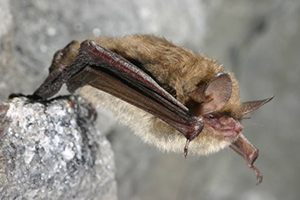
Northern Long-Eared Bat
(Myotis septentrionalis)Length: 8 cm
Wingspan: 25 cm
Northern Long-Eared Bats have dull yellow-brown fur with pale grey bellies. They usually weigh between six and nine grams. As their name suggests, they have long (rounded) ears. They can be distinguished by the fleshy projection that covers the entrance to the ear, which is long and thin, with a pointed tip. These bats hibernate from October or November to March or April, most often in caves or abandoned mines.
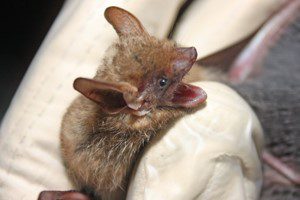
Tri-coloured Bat
(Perimyotis subflavus)Length: 8 cm
Wingspan: 25 cm
The Tri-coloured Bat is named for black, yellow and brown hairs on its back. They forage over water and along streams in the forest. Tri-colored Bats eat flying insects and spiders gleaned from webs. During the summer, the Tri-colored Bat is found in a variety of forested habitats. It forms day roosts and maternity colonies in older forest and occasionally in barns or other structures. The Tri-colored Bat weighs about 7 gm – the weight of a two dollar coin.
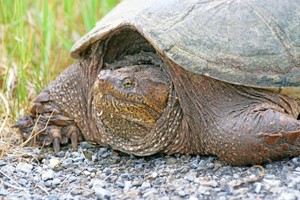
Snapping Turtle
(Chelydra serpentina)Carapace (shell) length: 20.3 to 50.3 cm
Snapping Turtles have large black, olive or brown shells typically covered in algae. Their tails, which can be longer than their bodies, have dinosaur-like triangular crests along their length. Hatchlings are about the size of a loonie and are smaller and darker than adults, with pronounced ridges along the length of their shell. Snapping Turtles spend most of their lives in water. They prefer shallow waters so they can hide under the soft mud and leaf litter, with only their noses exposed to the surface to breathe. The Snapping Turtle is Canada’s largest freshwater turtle and are believed to live well over 100 years.
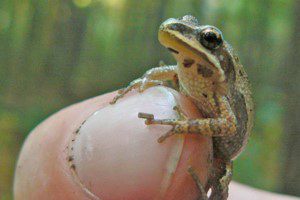
Western Chorus Frog
(Pseudacris triseriata)2 to 4 cm
The Western Chorus Frog is a small tree frog with three dark lines along its back and one larger line on each flank. Its ground colour can range from brown to grey to olive. The species is easily detected during spring because of its creaking call that resembles the sound of a fingernail stroked along a plastic comb. It is a secretive species and thus rarely seen outside the breeding season. This Western Chorus Frog breeds in almost any fishless pond with at least 10 centimetres of water.
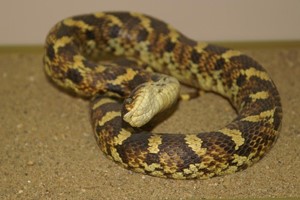
Eastern Hog-Nosed Snake
(Heterodon platirhinos)Length: 50 to 115 cm
The Eastern Hog-Nosed Snake owes its name to the upturned scale at the tip of its snout, unique to hog-nosed snakes. Individuals of this species are highly variable in colour and pattern. Some individuals have a distinctive pattern of irregular blotches down the back, alternating with dark spots along the side, on a background of grey, brown, tan, olive, orange, yellow, or pinkish colour, whereas others lack all patterning and are typically plain grey, brown, olive, or black. When threatened, it rears back and flattens out its head and neck like a cobra, then hisses and may strike, often leading people to think this harmless snake is venomous.
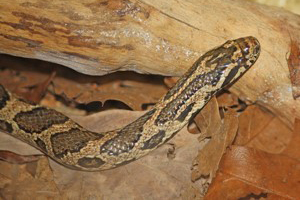
Milksnake
(Lampropeltis triangulum)Length: 60 to 130 cm
The Eastern Milksnake is tan, brown or grey and has large, black-outlined, red or brown dorsal blotches that fade as the snake ages. The Eastern Milksnake is often found in barns and stables where it readily finds small mammals, its predominant prey. Eastern Milksnakes are most common in regions with high forest cover. When threatened, the Eastern Milksnake will mimic a rattlesnake, vibrating its tail, but unlike rattlesnakes, they are not venomous and are harmless to humans.
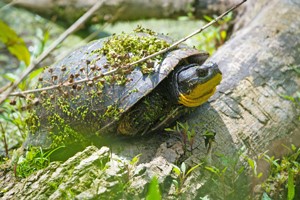
Blanding’s Turtle
(Emydoidea blandingii)Carapace (shell) Length: 15 to 27 cm
Blanding’s Turtle is a medium-sized turtle easily identified by its bright yellow throat and chin. Unlike most Ontario turtles with wide, flatter shells, Blanding’s Turtle has a domed shell that resembles an army helmet. Its shell is black to brown with yellow flecks and streaks, its head and limbs are black-grey and the bottom shell is rich yellow. Blanding’s Turtles live in shallow water, usually in large wetlands and shallow lakes with lots of water plants but can often be found hundreds of metres from the nearest water body, especially when searching for a mate or traveling to a nesting site. Unlike other Ontario turtles, the bottom shell is hinged and some Blanding’s Turtles can completely close their shell after pulling in their head and feet!
